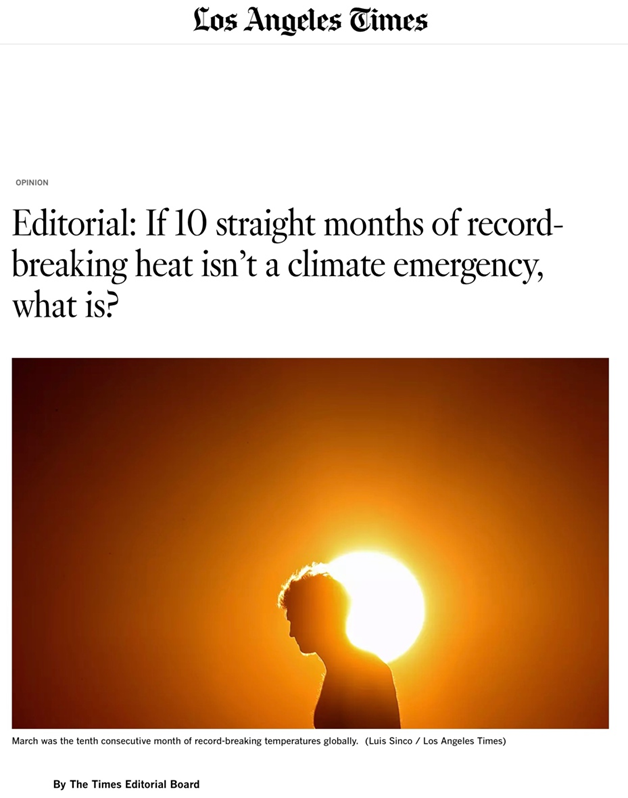New paper demonstrates climate models don’t even have the ‘basic physics’ of the greenhouse effect correct
http://hockeyschtick.blogspot.com/2013/10/new-paper-demonstrates-climate-models.html
A new paper published in Geophysical Research Letters inadvertently demonstrates that climate models don’t even have the so-called ‘basic physics’ of the greenhouse effect correct. According to the paper, climate models show that “With CO2 at or below 1/8 of the 1950 value [i.e. ~39 ppm], runaway sea ice does occur as the planet cascades to a snowball Earth climate with fully ice covered oceans and global mean surface temperatures near – 30 °C.”
However, -30°C is much colder than the -18°C calculated* for an Earth with no atmosphere or oceans or greenhouse effect at all! Further, -30°C is much, much colder [i.e. 35°C colder] than the +5°C calculated using the IPCC formula** for CO2 forcing using a CO2 level of 39 ppm.
It is astonishing that the authors, who claim to be top experts on the physics of CO2 radiative transfer, did not realize that their computer model is outputting physically-impossible GIGO.
Perhaps this is not surprising, since the paper is co-authored by Andrew “control knob” Lacis, who claims CO2 contributes 20% (alone) to the greenhouse effect. That means CO2 was responsible for 6.44C warming in 1850 [32.2*.2] and 6.6C now [33*.2], a warming effect of 0.2C despite a 40% increase in CO2 levels! [assuming a total ‘greenhouse effect’ of 33C].
Also using the same flawed climate model, the authors simulated the effect of 79,360 ppm CO2, 256 times the 1950 value [~310 ppm in 1950, current ~400 ppm], which would only take 39,480 years to reach at the current rate of 2 ppm/year, assuming unlimited fossil fuels and no intervening ice age of course. Despite the ridiculous 79,360 ppm levels of CO2, the authors state, “No water vapor induced runaway greenhouse caused by increased CO2 was found for the range of CO2 examined.”
The first 20 ppm accounts for over half of the alleged heating effect of CO2 to the pre-industrial level of 280 ppm, by which time carbon dioxide is tuckered out as a greenhouse gas. Source
Logarithmically declining CO2 forcing effect is greatest at the lower concentrations. Source
*note this simplistic calculation widely used in greenhouse effect calculations assumes a flat, stationary earth receiving 340 Wm-2 solar input instead of the physically realistic calculation using real-time differential thermal equations of a rotating Earth receiving 1362 Wm-2 solar input. Using the correct physical description of the solar-earth system results in an even greater disparity between the model output and the physics.
**5.35*ln(400/39) = 12.4 Wm-2 = IPCC alleged CO2 forcing at the top of the atmosphere from increasing CO2 levels from 39 ppm to 400 ppm
3C/3.7 Wm-2 * 12.4 Wm-2 = 10 C warming from increasing CO2 levels from 39 ppm to 400 ppm
Current global mean temperature is ~15C
15C-10C = +5C global mean surface temperature for an Earth with CO2 levels of ~39 ppm per the IPCC formula.Fast Atmosphere–ocean Model Runs with Large Changes in CO2Gary L. Russell, Andrew A. Lacis, David H. Rind, Christopher Colose, Roger F. OpstbaumDOI: 10.1002/2013GL056755
How does climate sensitivity vary with the magnitude of climate forcing? This question was investigated with the use of a modified coupled atmosphere–ocean model, whose stability was improved so that the model would accommodate large radiative forcings, yet be fast enough to reach rapid equilibrium. Experiments were performed in which atmospheric CO2 was multiplied by powers of two, from 1/64 to 256 times the 1950 value [of ~310 ppm]. From 8 to 32 times the 1950 CO2, climate sensitivity for doubling CO2 reaches 8 °C due to increases in water vapor absorption and cloud top height, and to reductions in low level cloud cover. As CO2 amount increases further, sensitivity drops as cloud cover and planetary albedo stabilize. No water vapor induced runaway greenhouse caused by increased CO2 was found for the range of CO2 examined. With CO2 at or below 1/8 of the 1950 value [~39 ppm], runaway sea ice does occur as the planet cascades to a snowball Earth climate with fully ice covered oceans and global mean surface temperatures near – 30 °C.
Erroneous greenhouse effect assumptions are only the tip of the iceberg for the multitude of other climate model failings



